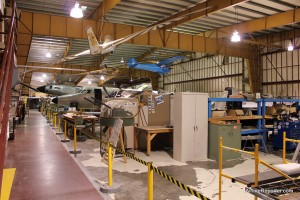
This is just one half of one of the hangars at the Museum of Flight's Restoration Center at Paine Field.
A while back I had the opportunity to check out the Museum of Flight at Boeing Field (KBFI), just south of Seattle. They have an amazing collection of aircraft and any aviation geek can find something of interest. They have vehicles on display that are covered in fabric to being found in space. Creating such an amazing collection doesn’t come easy and it takes an enormous amount of work to get old airplanes to museum quality. Where many visitors (and locals) will check out the Museum of Flight, many don’t get the whole story. A visit to check out the Museum of Flight Restoration Center, housed at Paine Field (KPAE), is a must for any aviation enthusiast.
The restoration work is mostly done by volunteers who use their time, skills and rarely even their own money to help restore the museum’s aircraft. These are people with a true passion for aviation and talking with them about their work is more exciting than viewing the actual airplanes. The facility employs only two staff, but has a roster of about 75 volunteers. The entire Aircraft Collections Department in Seattle and Everett, has a staff of three and over 125 volunteers. Volunteers will be broken up into teams and assigned to work on an aircraft. Director of Aircraft Collections and the Senior Curator will determine what needs to be done and work with the volunteers on the proper methods to do it. Since many parts can no longer be found or are too costly, in many cases, they end up making their own.
Restoring an airplane is difficult enough, but keeping it in good shape is a whole other ballgame. Most of the aircraft at the Museum of Flight and the Restoration Center are housed inside, which makes keeping them in prime condition easier. The challenge becomes the ones that live outside in the punishing Seattle weather. The Museum of Flight is in process of creating an indoor airpark to house the airliners that are outside now and the others (ie Comet, 1st 727 and Constellation) waiting to be put on display.
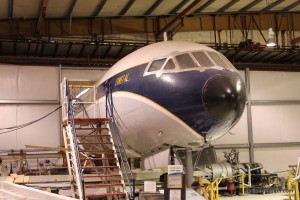
It becomes a challenging juggle between man-power, resources, money and time to keep such a large collection in pristine condition. The Restoration Center’s goal is not to get the aircraft to flying condition, but in a condition that they preserve the history of the aircraft type and of the individual plane. If the plane has damage on it, that can tell a story. They might not fully repair it since it is a part of the history of the aircraft.
Probably one of the most difficult tasks at the Museum of Flight or the Restoration Center is having to tell someone, “no,” when they have an aircraft that they want added to the collection. Boeing Field, where the Museum of Flight is located, is crowded and very expensive. Although the Restoration Center has been successfully expanding their hangar space at Paine Field throughout the years, it is becoming more difficult with the increased popularity.
Walking into the main lobby of the Restoration Center, you will find aviation related items almost everywhere. Although the lobby has some interesting things, it doesn’t compare to what you will find in the main hangar. When first entering the hangar, I had to pause and absorb everything. From old war birds, to military jets, to the front end of a Comet 4C sticking inside the hangar — I knew this was going to be a great visit. I am glad I had Tom Cathcart and TC Howard there to keep me on track or I might have just endlessly been wondering around the facility.
There are many wonderful planes with interesting stories (see all the photos), but here are three of my favorites:
THE DE HAVILLAND COMET 4C
I have seen the rear end of this plane sticking out of the hangar for many years, but had never made it inside. It is quite the site to see half the aircraft in the hangar and the rear half sticking out. This of course has caused some issues with the front being protected and the rear half being exposed to the elements. They are in the process of putting up a protective cover for the rear of the aircraft. This will make the view from outside less exciting, but it will keep the plane from deteriorating — which is well worth it.
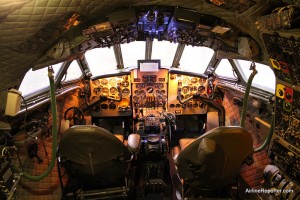
The wonderfully restored cockpit of the Comet 4C.
Stepping inside the Comet was like traveling through time. As I climbed on board, I tried to imagine what it must had been like for passengers to fly on a Comet for the first time. The Comet was the first production jet airliner and was a huge difference from their prop counterparts. What excitement passengers must have felt flying on a new generation or airliner. Yes, the Comet had some “breaking up in midair” issues at first, but by the time the Comet 4C came around, they had that sorted out.
This aircraft is being restored from the front to the back, which provides a nice insight on the process. The lavatory looked almost brand new and it was surreal seeing the photo on the wall showing what it looked like when they got the aircraft.
This exact aircraft (C/N 6424) had her first flight on October 31, 1959 and was delivered to Mexicana in July of 1960. The airplane was abandoned at Paine Field in 1979 before it was taken by Everett Community College for their students to work on. The problem was, it was a British aircraft and provided little help for American students learning how to work on American aircraft. Here is some more to explore:
* My photos of the Comet 4C during my visit
* More about the Comet 4C on the Museum of Flight’s website
* Some photos of the Comet’s restoration on Bob Bogash’s page
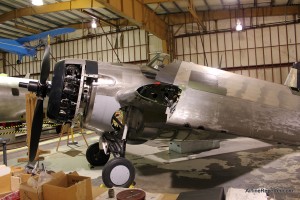
The Wildcat where you can see the new skin they put on versus the original on the wing.
THE FM-2 WILDCAT
The Wildcat is one slick plane, but I was mostly fascinated with how they have been restoring it. Like many of the other planes the Restoration Center receives, the plane wasn’t in the best of shape — it has been sitting at a park for many years. Since parts are difficult, expensive and time consuming to come by, 60% of this aircraft has been re-done in-house. You could see how some of the old skin on the aircraft remained, but much of is has been recently re-fabricated and placed on the aircraft.
On a work table there was a drawing, a paper mock up and a formed wood piece all made to re-make a part of the wing. The volunteers working there are a very creative and motivated group of people.
THE FIRST BOEING 727 (N7001U)
Ah, the first aircraft of a particular aircraft type is always a fun find. The Boeing 727-100 housed in the back of the Museum of Flight’s Restoration Center is N7001U and was the first 727 ever produced. After completing her flight testing, she served a long career with United Airlines. Unlike most other Boeing test programs, there was no dedicated test aircraft for the 727 program. The first one built was used for testing and then put into service.
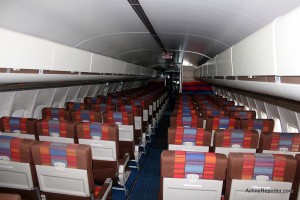
The interior of the 727 looks almost like it did when it was delivered. Can you see the obvious difference?
The plane was delivered to United on October 6, 1964 and after her long career, was delivered to the Museum of Flight in January 1991. Between that time, the aircraft flew almost 65,000 hours, made over 48,000 landings and few about 3 million passengers. The plane was configured to have the same livery and interior it had when it was first sold to United in 1964. At the time, the aircraft was gorgeous and still flight worthy. Unfortunatly United ended up removing many parts needed to keep the aircraft airborne and the Restoration Center has been working since to get this beauty back in the air.
That’s right. The goal is not to just to keep the aircraft in good shape, but also to get it where she can be flown from the Restoration Center at Paine Field, south about 30 miles to Boeing Field. It is a race against time to put new parts on the airplane while making sure it stays in good condition. In the past five years they have gotten parts donated from Clay Lacey’s old Boeing 727-200 (the cockpit is on display at the Future of Flight) and from Marcella, the Eastern Air Lines turned FedEx Boeing 727-200, whose front end is housed at the Future of Flight.
Much like walking into the Comet, the interior of the Boeing 727 takes you back in time. The colorful seats, the brown wallpaper and of course that very colorful carpet on the bulkhead. The cockpit looked like she was ready to fly and hopefully someday she might get that chance. Here is some additional information and photos of N7001U:
* My photos of N7001U inside and out
* Photos and information on the first 727 on the Museum of Flight’s site
* Additional information from Bob Bogash’s site
* Photo of the 727 in United Airline Tulip Livery
* Photo of the 727 in United Friendship Livery
The Restoration Center is not just a great place to visit, but to also learn how the restoration process works. I know many of you that read this blog have skills that could be very useful with many of their projects. If you are looking for something to do to keep you busy and you want to help out with history, the Restoration Center is always looking for dedicated people to help out. Otherwise, you are always welcome to visit (it only costs $5) to see the restoration process for yourself.
If you want more eye candy, be sure to check out the additional photos. This review will be added to my Aviation in Seattle page.
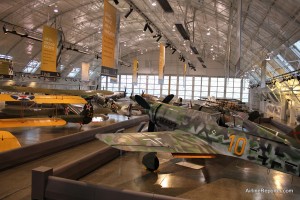
One large hangar holds all the airplanes in the Flying Heritage Collection
Around the world there are a lot of old war birds on display for many to enjoy. However, there aren’t too many that are kept in original condition and are still flyable. This is one of the things that makes the Flying Heritage Collection (FHC) stand out from others. Recently I was able to take a visit to the facility to check it out — sadly I had never been.
One of the first things I noticed when going inside the old hangar, housing the aircraft, was the smell. This is something that will not come through in the photos, but it is an important part of the experience. You can smell the fluids of the aircraft. When visiting most museums there is no smell since the aircraft have not flown in years. It feels like you are walking into a full operational hangar — and in a way you are.
Of course the smell is not the only special part of the facility, you have got to love those planes. At first site, it might seem the Flying Heritage Collection is about showing off a very slick collection of aircraft, but it is not only about the story of the planes, but also the story of technology. Finding any of these aircraft is a hard thing to do, but to find them in flying form is extremely rare. The FHC works hard to refurbish the aircraft with as many original parts as possible. Somethings like wiring needs to be updated according the FAA, but they will re-wire the plane and wrap them all in the original fabric to keep to as close to rolling out of the factory as possible.
There are two aircraft in the collection that are flyable, but are not flown. The Focke Wulf D-13 Dora and the Nakajima Ki-43-1B Hayabusa Oscar are the only examples of their kind left. The FHC doesn’t want to fly them for fear that they might be damaged or even worse crash and then there would be none left for the world to enjoy.
It is a bit surprising, when first walking into the hangar, you do not see planes, but tanks. These are a new additions to the collection and just like the airplanes, they both work. These are a new addition to the facility and were added last Memorial Day. The Soviet T-34 and a German Jagdpanzer 38(t) obviously aren’t planes, but they help to tell the story of updates in technology produced through war. Just like the airplanes, these tanks are fully functional and are able of shooting.
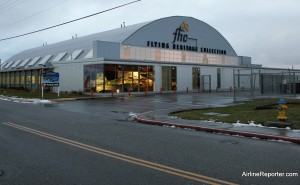
The Flying Heritage Collection is located at Paine Field in Everett, WA
Taking a look at the airplanes is quite exciting, but the FHC does a good job putting the aircraft into perspective. As you would expect in a facility like this, every airplane has a place card explaining the basics of the aircraft, but they also give a history of that individual airplane, which was quite interesting. On the walls around the facility are story boards about how each country interacted with the aircraft and gives a bit more historical significance. Hanging from the ceiling are banners that explain when new technologies were discovered. For example, there was a banner that explained in 1942 ejection seats were invented and increased the odds of a pilot’s survival. It is interesting to compare the dates from the banners with the dates the aircraft were produced.
When I asked about how much each aircraft cost, I was told “a lot.” I would imagine that “a lot,” might be an understatement, it can’t be cheap to keep the planes in the condition that they are. Cost of the aircraft really isn’t a huge issue, since the facility is owned by Paul Allen, co-founder of Microsoft and chairman of Vulcan. On top of giving a lot of his money away for good causes, he also has a lot of fun toys. Luckily for us, he has decided to share his collection of warbirds with the public through his non-profit organization, Friends of Flying Heritage that supports the collection.
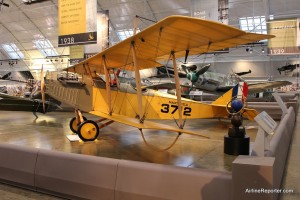
The oldest aircraft they have is the Curtis JN-4D Jenny - and it still flies.
The collection was open to the public in 2004 and was housed in Arlington, WA (about an hour north of Seattle, WA). In 2008 they moved to their current facility right on Paine Field. Right now there is only one more slot left for another plane and I was told they might have to start storing aircraft in Arlington and rotate them through the collection. Although it would be better to see all the collection at any given time, this also means you might be able to catch one flying between the two airports, which is always a good thing.
If you haven’t done so already, head on over to the Flying Heritage Collection and check them out. Tickets are only $12 and less for kids and seniors. Also be sure to make it to Paine Field for their Free Fly Days when you can watch them fly for free over the summer. They will fly the planes 10 different days over the summer, kicking it off during General Aviation Day.
I will be adding this write up in the Aviation in Seattle page, it should make a great addition. A special thanks to the Flying Heritage Collection and Snohomish County Tourism Bureau for setting up my visit.
MORE FUN STUFF:
* 29 Photos of my visit to the collection
* See photos of the planes flying from Liz Matzelle (be sure to catch the one with 787 ZA005 and the spitfire)
* Flying Heritage Collection Facebook page
* Build your own warbird on their website
* Photos of the tanks firing at Paine Field last year from the SEattle PI
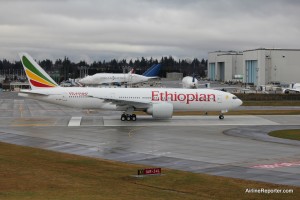
Ethiopian Airlines Boeing 777-200LR (ET-ANP) at Paine Field. Click for more photos.
Ah, the life of waiting for a first flight in Seattle: cold, rain, wind, but no Boeing 787 Dreamliner. ZA102, the ninth Dreamliner, was set to take off for the first time today, but it has been pushed until at least tomorrow, Tuesday. The engines started up for a while, but then shut down and the left cowl was opened up. This didn’t mean Paine Field was short of any action this morning. There were two Boeing 777’s that took off, one Boeing 747-8 (BOE503) and a few Ryanair Boeing 737’s that did touch and goes.
CHECK OUT THE EYE CANDY FROM PAINE FIELD
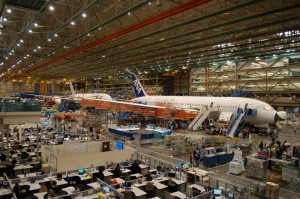
ZA102 sitting on the factory floor in June 2010. Photo by Jon Ostrower.
Jon Ostrower (via Flight Blogger) and Matt Cawby (via KPAE blog) have both confirmed that the 9th Boeing 787 Dreamliner (ZA102 – N1006F), will be taking flight from Paine Field tomorrow. Although Boeing doesn’t confirm the time of lift off, I assume it should be around 10am.
ZA102 will be the first Dreamliner to actually be delivered to an airline and fly passengers. It is painted in the All Nippon Airways (ANA) tail, but has a white body. It is expected that ANA will have a special livery for this Dreamliner.
If you are in the Seattle area and have Monday off, head on over to Paine Field and experience a Dreamliner taking off for the first time. The weather says it will most likely rain, but that shouldn’t stop you. I am hoping to try and do a live video feed via my iPhone, but we shall see how it goes. Follow Twitter for the updates on the first flight of ZA102.
We are all still waiting on Boeing’s updated delivery schedule for the Boeing 787 Dreamliner after ZA002’s fire. For more information on the rest of the 787 test fleet, check out Ostrower’s most recent blog.
UPDATE HERE
Image: Jon Ostrower
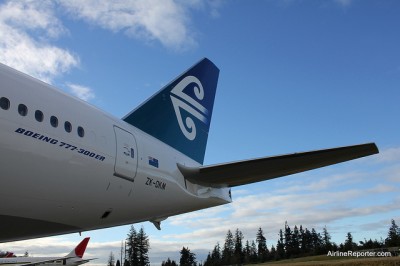
Air New Zealand's first Boeing 777-300ER (ZK-OKM) parked next to the Future of Flight at Paine Field
Yesterday was quite the amazing day. Air New Zealand took delivery of their first Boeing 777-300ER. Not only is this the first of five that Air New Zealand will take delivery on, this aircraft also showcases their new interior and new slightly updated livery.
Many different companies will hype something as being new and “the next best thing,” then when you actually see it, you are left feeling disappointed. I have been looking forward to Air New Zealand’s new interior since they announced their Sky Couches almost a year ago (heck, I even gave the seats an “Awesome Medal“). What better way to check out the new interior than catch the plane’s first flight with passengers? Air New Zealand was kind enough to invite me to their delivery ceremony (I will blog about the actual delivery in the future) and get a tour of the plane before taking a short flight down to Los Angeles (disclaimer: I did not pay for the Air New Zealand flight to LAX, but did pay for a flight back to Seattle).
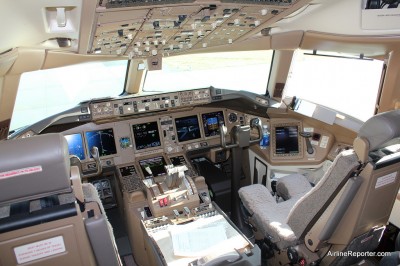
The flight deck of the Boeing 777-300ER.
This new interior was set to premier in Air New Zealand’s first Boeing 787 Dreamliner, but due to the delays they decided to put the interior on their Boeing 777-300ER aircraft. When first walking on, you can tell it is different. Modern, clean, trendy and it smelled good. If you like that new car smell, you would love new airplane smell.
The best seats start at the front of the plane and work their way back. And when I say front, I mean the very front. The cockpit of the Boeing 777-300ER is very roomy and someplace I wouldn’t mind hanging out for a few hours. Although they might be best seats in the house, you aren’t able to buy your way into them (other than putting in the time to be a pilot).
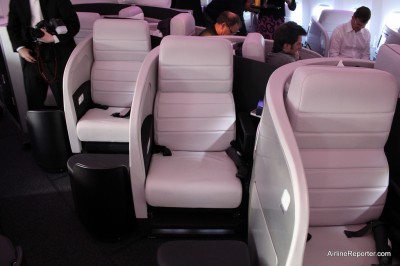
These are the very roomy Business Select seats up front.
The best seats you can actually pay for are located in the Business Premier section at the front of the plane. They have what you expect to see in a premium long haul international seat plus some. They provide a totally flat bed (with memory foam top), a cozy duvet, fluffy pillows, in-flight entertainment and a nice big table you can use to dine alone or with a guest on the small guest seat. The seats are tilted which can give you quite a bit of privacy, but they still allow you to have a conversation with those around you. I was lucky enough to be sitting in one of these seats on the delivery flight from Paine Field (PAE) to LAX and I have to say it was quite impressive (I am actually writing this at the seat right now with a laptop, food, paperwork, drink and camera on the table as well).
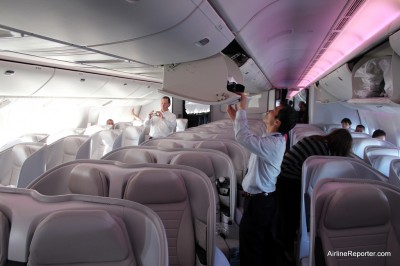
These are the clever Premium Economy seats at a slight angle.
The next option is Premium Economy. Some American airlines might have “premium economy” where it is a standard economy seat with a few more inches of room or near the front of the plane. These are high-end seats that provide ample room and entertainment. The seats do not lie-flat, but it still wouldn’t stop someone from having a good rest. The angle provides a good fit if you are traveling alone and want some privacy, but it is not enough to hinder two people flying together.
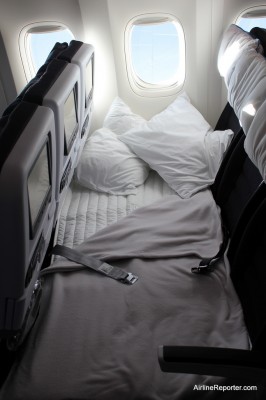
The very comfy Sky Couch seen enroute to LAX.
Who says that economy can’t be made fun? When heading farther back into the aircraft you come to black economy seats, but some of these seats are created better than the others. There are 20 sets of seats on the aircraft that can be transformed into a sky-couch. This is a great feat not only for Air New Zealand and Recaro (the company that designed them) but also the future of airline travel. Even though the couch provides a 5’1″ length, I was able to lay down and be quite comfortable at 6’1″. Lie-flat seats have been all the rage in First and Business Class seats for international airlines and Air New Zealand wanted to take it to the next level in economy. However, I plan to detail the Sky Couch seats in more detail in a future blog, since they deserve one.
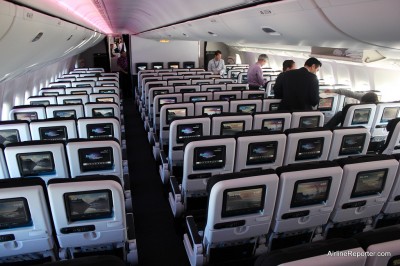
This is economy class, where you will find the Sky Couch and standard economy seats.
If you do not get a Sky-Couch economy seat, do not worry, things still aren’t too shabby. The remainder of the seats are your standard economy seats. Each one still has their own in-flight entertainment screen, PC power and USB and iPod connections (all the seats on board do). You also get a nice little foot net to change up your seating position during those longs flights.
No matter where you are sitting, you are able to enjoy Air New Zealand’s new food options. All seats allow passengers to order food from their seat anytime during the flight. Meal service on your terms, not according to the clock. This Boeing 777-300ER is is the first aircraft to have induction ovens allowing the airline to offer more food choices for customers. Want your steak medium-rare? Sure thing (Well, Business Select are the only folks to get steak. But other classes do have other great food options). Since our flight was so short we weren’t able to experience the entire meal, but they did offer an array of high-end snacks like shrimp, duck and lamb. If the food served is any indication of the full meals, I am quite impressed.
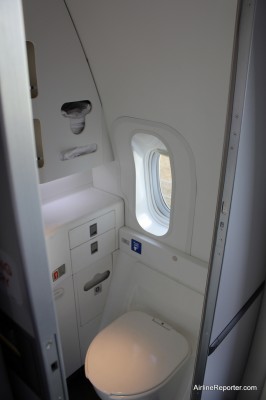
Check out this window in the restroom.
The aircraft has nice little touches as well. In a few of the lavatories you will actually find a window to the outside. Nothing like seeing the terrain below as you do your business. If you do not want to look out the window, others have interesting images on the wall, like a bookshelf and chandelier. There are other neat additions like a concierge area (and there is a concierge on-board too) to help you find what to do when you arrive at your destination. If you have kids, they can enjoy story time with one of the on-board crew. Otherwise you have a great in-flight entertainment system with quite a few options — all free. Of course, I think one of the coolest features was the service (and that New Zealand accent).
The two hour flight to LAX was way too short. I would have loved to stay on-board and experience the luxury and near luxury treats for a full 13hr test flight down to Auckland. However, since it is close to the holidays I had to make my way back up to Seattle instead. I hope this is not the last time I come in contact with one of Air New Zealand’s Boeing 777-300ER’s.
CHECK OUT ALL 102 PHOTOS FROM THE DELIVERY FLIGHT
* News video on the SkyCouch (at 0:48 you can see me as I wrote this blog and 1:30 a few words)
* Photos and video of the Air New Zealand Boeing 777-300ER taking off from Paine Field
















